Tourism Planning: Critical Assessment of Discussion Papers
VerifiedAdded on 2023/06/09
|7
|1701
|136
Report
AI Summary
This report offers a critical assessment of two tourism discussion papers focusing on strategic planning and sustainable tourism development. The report begins by introducing the papers and highlighting key issues, such as the importance of strategic planning for tourism investment and the scope of sustainable tourism's potential. It then critiques the structure of each paper against the policy planning cycle, noting the strengths and weaknesses in their approach. The report also evaluates the sufficiency of the papers for relevant stakeholders, considering the inclusion of information pertinent to private sectors, government authorities, and local populations. A comparison of the papers follows, examining their structure, quality, and effectiveness in communicating with the target audience, with observations on language complexity and data presentation. The report concludes with a reflection on the learning experience, highlighting the acquisition of academic writing skills and the importance of information selection in the context of tourism policy. The report references both academic journals and online sources used in the analysis.
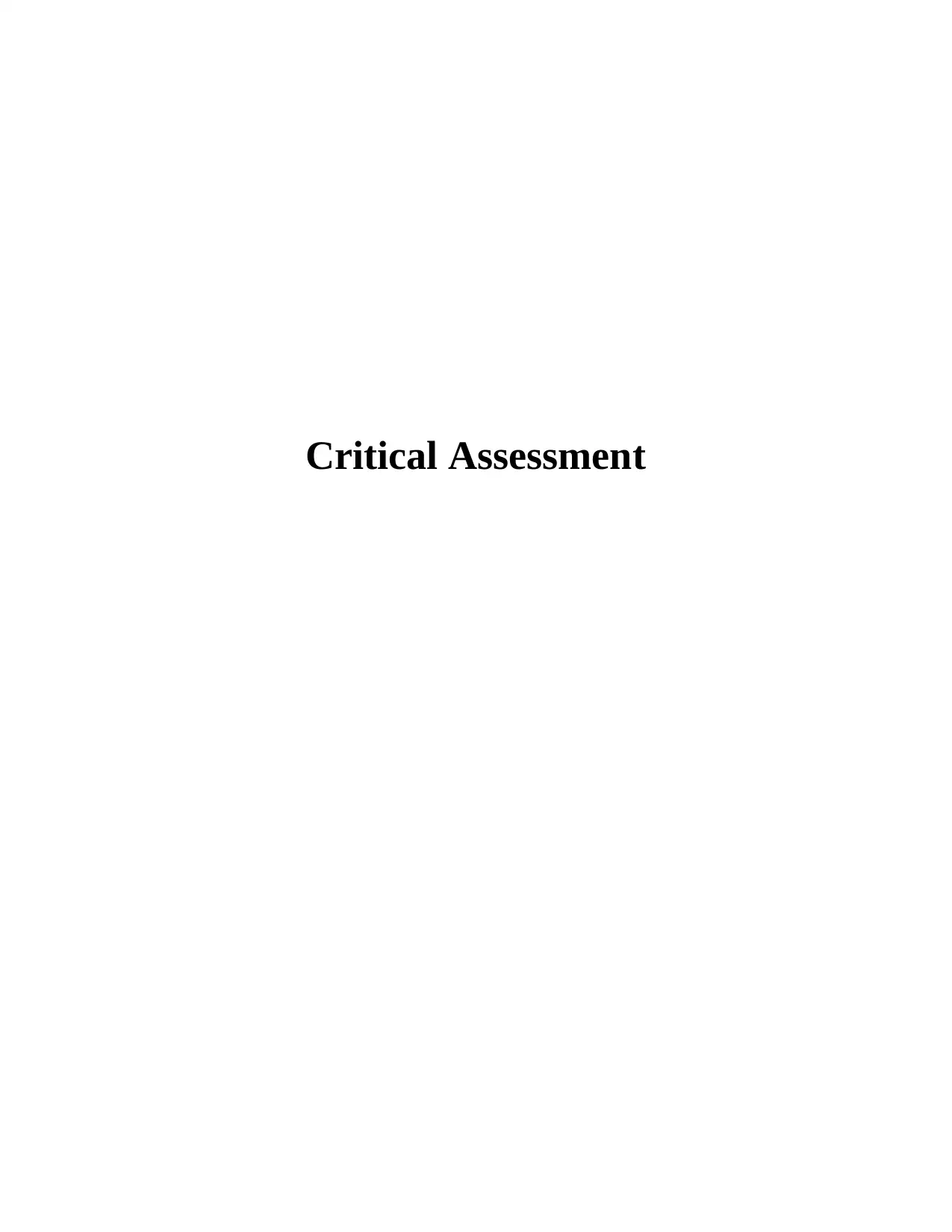
Critical Assessment
Paraphrase This Document
Need a fresh take? Get an instant paraphrase of this document with our AI Paraphraser
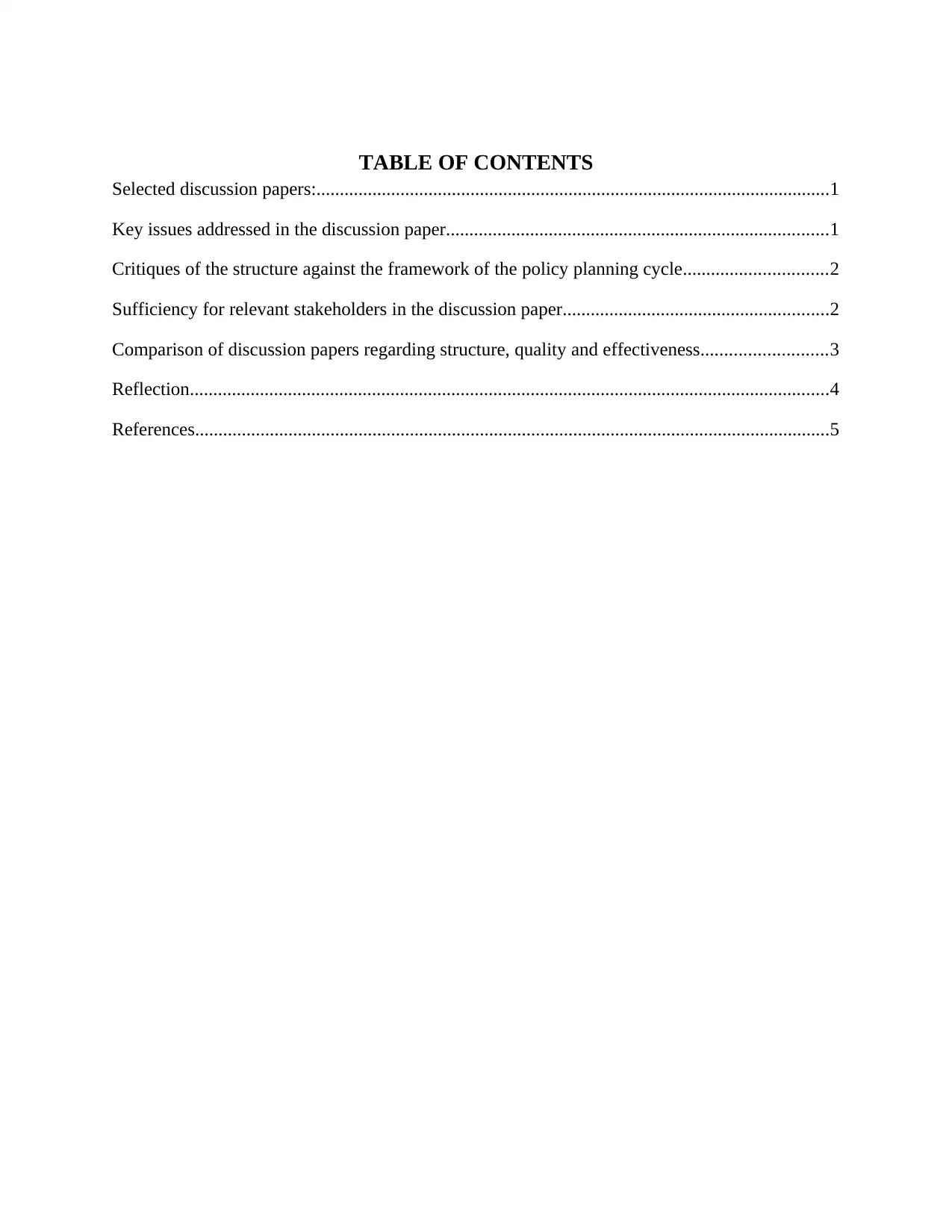
TABLE OF CONTENTS
Selected discussion papers:..............................................................................................................1
Key issues addressed in the discussion paper..................................................................................1
Critiques of the structure against the framework of the policy planning cycle...............................2
Sufficiency for relevant stakeholders in the discussion paper.........................................................2
Comparison of discussion papers regarding structure, quality and effectiveness...........................3
Reflection.........................................................................................................................................4
References........................................................................................................................................5
Selected discussion papers:..............................................................................................................1
Key issues addressed in the discussion paper..................................................................................1
Critiques of the structure against the framework of the policy planning cycle...............................2
Sufficiency for relevant stakeholders in the discussion paper.........................................................2
Comparison of discussion papers regarding structure, quality and effectiveness...........................3
Reflection.........................................................................................................................................4
References........................................................................................................................................5
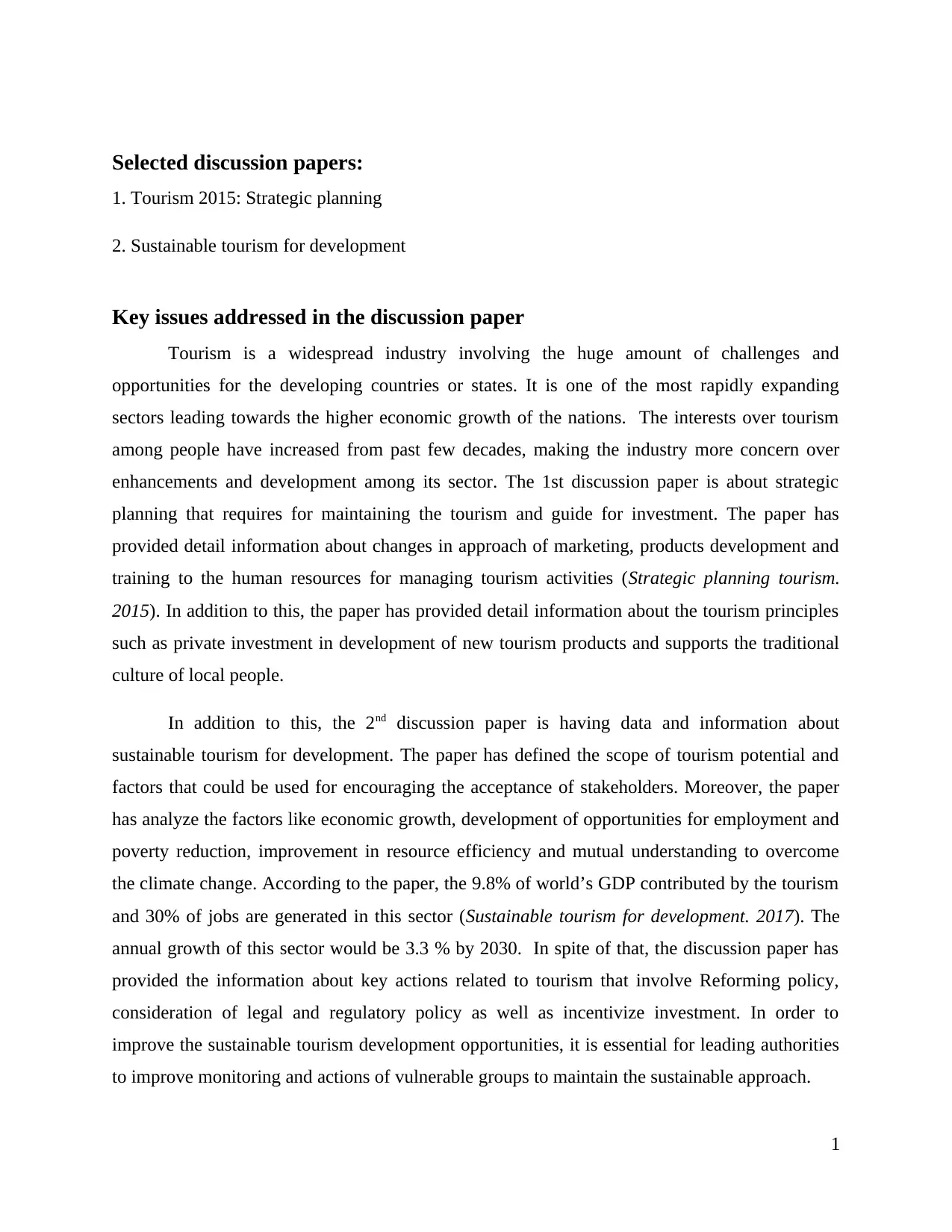
Selected discussion papers:
1. Tourism 2015: Strategic planning
2. Sustainable tourism for development
Key issues addressed in the discussion paper
Tourism is a widespread industry involving the huge amount of challenges and
opportunities for the developing countries or states. It is one of the most rapidly expanding
sectors leading towards the higher economic growth of the nations. The interests over tourism
among people have increased from past few decades, making the industry more concern over
enhancements and development among its sector. The 1st discussion paper is about strategic
planning that requires for maintaining the tourism and guide for investment. The paper has
provided detail information about changes in approach of marketing, products development and
training to the human resources for managing tourism activities (Strategic planning tourism.
2015). In addition to this, the paper has provided detail information about the tourism principles
such as private investment in development of new tourism products and supports the traditional
culture of local people.
In addition to this, the 2nd discussion paper is having data and information about
sustainable tourism for development. The paper has defined the scope of tourism potential and
factors that could be used for encouraging the acceptance of stakeholders. Moreover, the paper
has analyze the factors like economic growth, development of opportunities for employment and
poverty reduction, improvement in resource efficiency and mutual understanding to overcome
the climate change. According to the paper, the 9.8% of world’s GDP contributed by the tourism
and 30% of jobs are generated in this sector (Sustainable tourism for development. 2017). The
annual growth of this sector would be 3.3 % by 2030. In spite of that, the discussion paper has
provided the information about key actions related to tourism that involve Reforming policy,
consideration of legal and regulatory policy as well as incentivize investment. In order to
improve the sustainable tourism development opportunities, it is essential for leading authorities
to improve monitoring and actions of vulnerable groups to maintain the sustainable approach.
1
1. Tourism 2015: Strategic planning
2. Sustainable tourism for development
Key issues addressed in the discussion paper
Tourism is a widespread industry involving the huge amount of challenges and
opportunities for the developing countries or states. It is one of the most rapidly expanding
sectors leading towards the higher economic growth of the nations. The interests over tourism
among people have increased from past few decades, making the industry more concern over
enhancements and development among its sector. The 1st discussion paper is about strategic
planning that requires for maintaining the tourism and guide for investment. The paper has
provided detail information about changes in approach of marketing, products development and
training to the human resources for managing tourism activities (Strategic planning tourism.
2015). In addition to this, the paper has provided detail information about the tourism principles
such as private investment in development of new tourism products and supports the traditional
culture of local people.
In addition to this, the 2nd discussion paper is having data and information about
sustainable tourism for development. The paper has defined the scope of tourism potential and
factors that could be used for encouraging the acceptance of stakeholders. Moreover, the paper
has analyze the factors like economic growth, development of opportunities for employment and
poverty reduction, improvement in resource efficiency and mutual understanding to overcome
the climate change. According to the paper, the 9.8% of world’s GDP contributed by the tourism
and 30% of jobs are generated in this sector (Sustainable tourism for development. 2017). The
annual growth of this sector would be 3.3 % by 2030. In spite of that, the discussion paper has
provided the information about key actions related to tourism that involve Reforming policy,
consideration of legal and regulatory policy as well as incentivize investment. In order to
improve the sustainable tourism development opportunities, it is essential for leading authorities
to improve monitoring and actions of vulnerable groups to maintain the sustainable approach.
1
⊘ This is a preview!⊘
Do you want full access?
Subscribe today to unlock all pages.

Trusted by 1+ million students worldwide
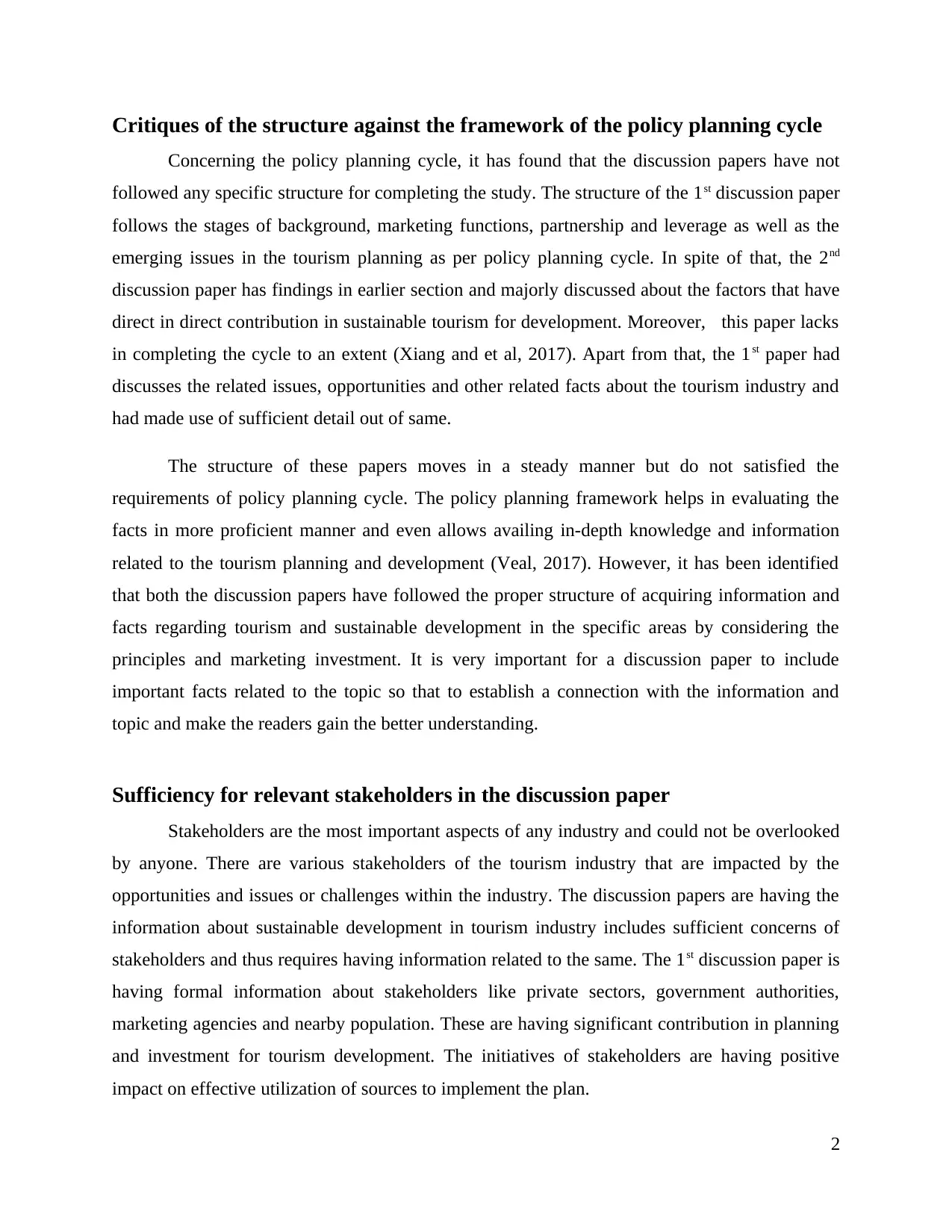
Critiques of the structure against the framework of the policy planning cycle
Concerning the policy planning cycle, it has found that the discussion papers have not
followed any specific structure for completing the study. The structure of the 1st discussion paper
follows the stages of background, marketing functions, partnership and leverage as well as the
emerging issues in the tourism planning as per policy planning cycle. In spite of that, the 2nd
discussion paper has findings in earlier section and majorly discussed about the factors that have
direct in direct contribution in sustainable tourism for development. Moreover, this paper lacks
in completing the cycle to an extent (Xiang and et al, 2017). Apart from that, the 1st paper had
discusses the related issues, opportunities and other related facts about the tourism industry and
had made use of sufficient detail out of same.
The structure of these papers moves in a steady manner but do not satisfied the
requirements of policy planning cycle. The policy planning framework helps in evaluating the
facts in more proficient manner and even allows availing in-depth knowledge and information
related to the tourism planning and development (Veal, 2017). However, it has been identified
that both the discussion papers have followed the proper structure of acquiring information and
facts regarding tourism and sustainable development in the specific areas by considering the
principles and marketing investment. It is very important for a discussion paper to include
important facts related to the topic so that to establish a connection with the information and
topic and make the readers gain the better understanding.
Sufficiency for relevant stakeholders in the discussion paper
Stakeholders are the most important aspects of any industry and could not be overlooked
by anyone. There are various stakeholders of the tourism industry that are impacted by the
opportunities and issues or challenges within the industry. The discussion papers are having the
information about sustainable development in tourism industry includes sufficient concerns of
stakeholders and thus requires having information related to the same. The 1st discussion paper is
having formal information about stakeholders like private sectors, government authorities,
marketing agencies and nearby population. These are having significant contribution in planning
and investment for tourism development. The initiatives of stakeholders are having positive
impact on effective utilization of sources to implement the plan.
2
Concerning the policy planning cycle, it has found that the discussion papers have not
followed any specific structure for completing the study. The structure of the 1st discussion paper
follows the stages of background, marketing functions, partnership and leverage as well as the
emerging issues in the tourism planning as per policy planning cycle. In spite of that, the 2nd
discussion paper has findings in earlier section and majorly discussed about the factors that have
direct in direct contribution in sustainable tourism for development. Moreover, this paper lacks
in completing the cycle to an extent (Xiang and et al, 2017). Apart from that, the 1st paper had
discusses the related issues, opportunities and other related facts about the tourism industry and
had made use of sufficient detail out of same.
The structure of these papers moves in a steady manner but do not satisfied the
requirements of policy planning cycle. The policy planning framework helps in evaluating the
facts in more proficient manner and even allows availing in-depth knowledge and information
related to the tourism planning and development (Veal, 2017). However, it has been identified
that both the discussion papers have followed the proper structure of acquiring information and
facts regarding tourism and sustainable development in the specific areas by considering the
principles and marketing investment. It is very important for a discussion paper to include
important facts related to the topic so that to establish a connection with the information and
topic and make the readers gain the better understanding.
Sufficiency for relevant stakeholders in the discussion paper
Stakeholders are the most important aspects of any industry and could not be overlooked
by anyone. There are various stakeholders of the tourism industry that are impacted by the
opportunities and issues or challenges within the industry. The discussion papers are having the
information about sustainable development in tourism industry includes sufficient concerns of
stakeholders and thus requires having information related to the same. The 1st discussion paper is
having formal information about stakeholders like private sectors, government authorities,
marketing agencies and nearby population. These are having significant contribution in planning
and investment for tourism development. The initiatives of stakeholders are having positive
impact on effective utilization of sources to implement the plan.
2
Paraphrase This Document
Need a fresh take? Get an instant paraphrase of this document with our AI Paraphraser
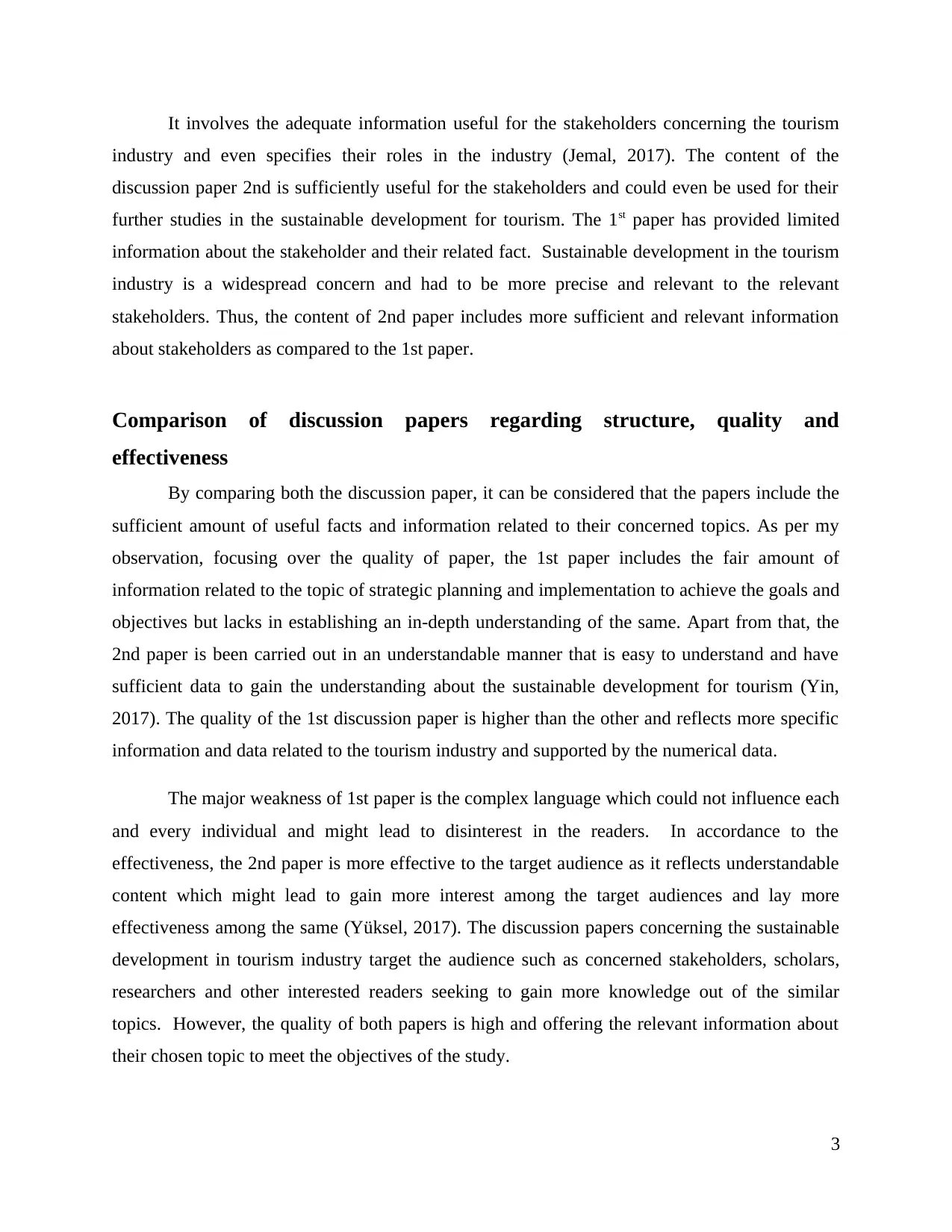
It involves the adequate information useful for the stakeholders concerning the tourism
industry and even specifies their roles in the industry (Jemal, 2017). The content of the
discussion paper 2nd is sufficiently useful for the stakeholders and could even be used for their
further studies in the sustainable development for tourism. The 1st paper has provided limited
information about the stakeholder and their related fact. Sustainable development in the tourism
industry is a widespread concern and had to be more precise and relevant to the relevant
stakeholders. Thus, the content of 2nd paper includes more sufficient and relevant information
about stakeholders as compared to the 1st paper.
Comparison of discussion papers regarding structure, quality and
effectiveness
By comparing both the discussion paper, it can be considered that the papers include the
sufficient amount of useful facts and information related to their concerned topics. As per my
observation, focusing over the quality of paper, the 1st paper includes the fair amount of
information related to the topic of strategic planning and implementation to achieve the goals and
objectives but lacks in establishing an in-depth understanding of the same. Apart from that, the
2nd paper is been carried out in an understandable manner that is easy to understand and have
sufficient data to gain the understanding about the sustainable development for tourism (Yin,
2017). The quality of the 1st discussion paper is higher than the other and reflects more specific
information and data related to the tourism industry and supported by the numerical data.
The major weakness of 1st paper is the complex language which could not influence each
and every individual and might lead to disinterest in the readers. In accordance to the
effectiveness, the 2nd paper is more effective to the target audience as it reflects understandable
content which might lead to gain more interest among the target audiences and lay more
effectiveness among the same (Yüksel, 2017). The discussion papers concerning the sustainable
development in tourism industry target the audience such as concerned stakeholders, scholars,
researchers and other interested readers seeking to gain more knowledge out of the similar
topics. However, the quality of both papers is high and offering the relevant information about
their chosen topic to meet the objectives of the study.
3
industry and even specifies their roles in the industry (Jemal, 2017). The content of the
discussion paper 2nd is sufficiently useful for the stakeholders and could even be used for their
further studies in the sustainable development for tourism. The 1st paper has provided limited
information about the stakeholder and their related fact. Sustainable development in the tourism
industry is a widespread concern and had to be more precise and relevant to the relevant
stakeholders. Thus, the content of 2nd paper includes more sufficient and relevant information
about stakeholders as compared to the 1st paper.
Comparison of discussion papers regarding structure, quality and
effectiveness
By comparing both the discussion paper, it can be considered that the papers include the
sufficient amount of useful facts and information related to their concerned topics. As per my
observation, focusing over the quality of paper, the 1st paper includes the fair amount of
information related to the topic of strategic planning and implementation to achieve the goals and
objectives but lacks in establishing an in-depth understanding of the same. Apart from that, the
2nd paper is been carried out in an understandable manner that is easy to understand and have
sufficient data to gain the understanding about the sustainable development for tourism (Yin,
2017). The quality of the 1st discussion paper is higher than the other and reflects more specific
information and data related to the tourism industry and supported by the numerical data.
The major weakness of 1st paper is the complex language which could not influence each
and every individual and might lead to disinterest in the readers. In accordance to the
effectiveness, the 2nd paper is more effective to the target audience as it reflects understandable
content which might lead to gain more interest among the target audiences and lay more
effectiveness among the same (Yüksel, 2017). The discussion papers concerning the sustainable
development in tourism industry target the audience such as concerned stakeholders, scholars,
researchers and other interested readers seeking to gain more knowledge out of the similar
topics. However, the quality of both papers is high and offering the relevant information about
their chosen topic to meet the objectives of the study.
3

Reflection
The comparative analysis of discussion papers related to Strategic planning and
Sustainable Development for Tourism has helped me to understand the factors and issues that are
considered for managing the process and approach of tourism in current scenario. I have gained
the information about critical environmental elements like the proper assessment of areas for
planning the tourism activities and effective utilization of natural resources. The study has also
helped to increase the knowledge about various functions related to the sustainable distribution
of economic benefits and maintain the social welfare approach to prevent the environment. The
environmental tourism is helpful for increasing the numbers of visitors and support to improve
the business opportunities for local populations.
By completing the comparative analysis of discussion papers related to strategic planning
and sustainable development for tourism, I have learned to use professional academic writing
skills. The selection of authentic information and consideration of data which is relevant to study
will help me in future studies. Apart from that, analysis of key information to compare the study
will also support to maintain the ethical and process to improve the flow of own study. However,
I am concern about writing but I have to craft improvement in the selection of studies and proper
management of time. I am also lacking in decision making to choose the appropriate information
to present in the study that increases the reliability and validity of the research.
4
The comparative analysis of discussion papers related to Strategic planning and
Sustainable Development for Tourism has helped me to understand the factors and issues that are
considered for managing the process and approach of tourism in current scenario. I have gained
the information about critical environmental elements like the proper assessment of areas for
planning the tourism activities and effective utilization of natural resources. The study has also
helped to increase the knowledge about various functions related to the sustainable distribution
of economic benefits and maintain the social welfare approach to prevent the environment. The
environmental tourism is helpful for increasing the numbers of visitors and support to improve
the business opportunities for local populations.
By completing the comparative analysis of discussion papers related to strategic planning
and sustainable development for tourism, I have learned to use professional academic writing
skills. The selection of authentic information and consideration of data which is relevant to study
will help me in future studies. Apart from that, analysis of key information to compare the study
will also support to maintain the ethical and process to improve the flow of own study. However,
I am concern about writing but I have to craft improvement in the selection of studies and proper
management of time. I am also lacking in decision making to choose the appropriate information
to present in the study that increases the reliability and validity of the research.
4
⊘ This is a preview!⊘
Do you want full access?
Subscribe today to unlock all pages.

Trusted by 1+ million students worldwide
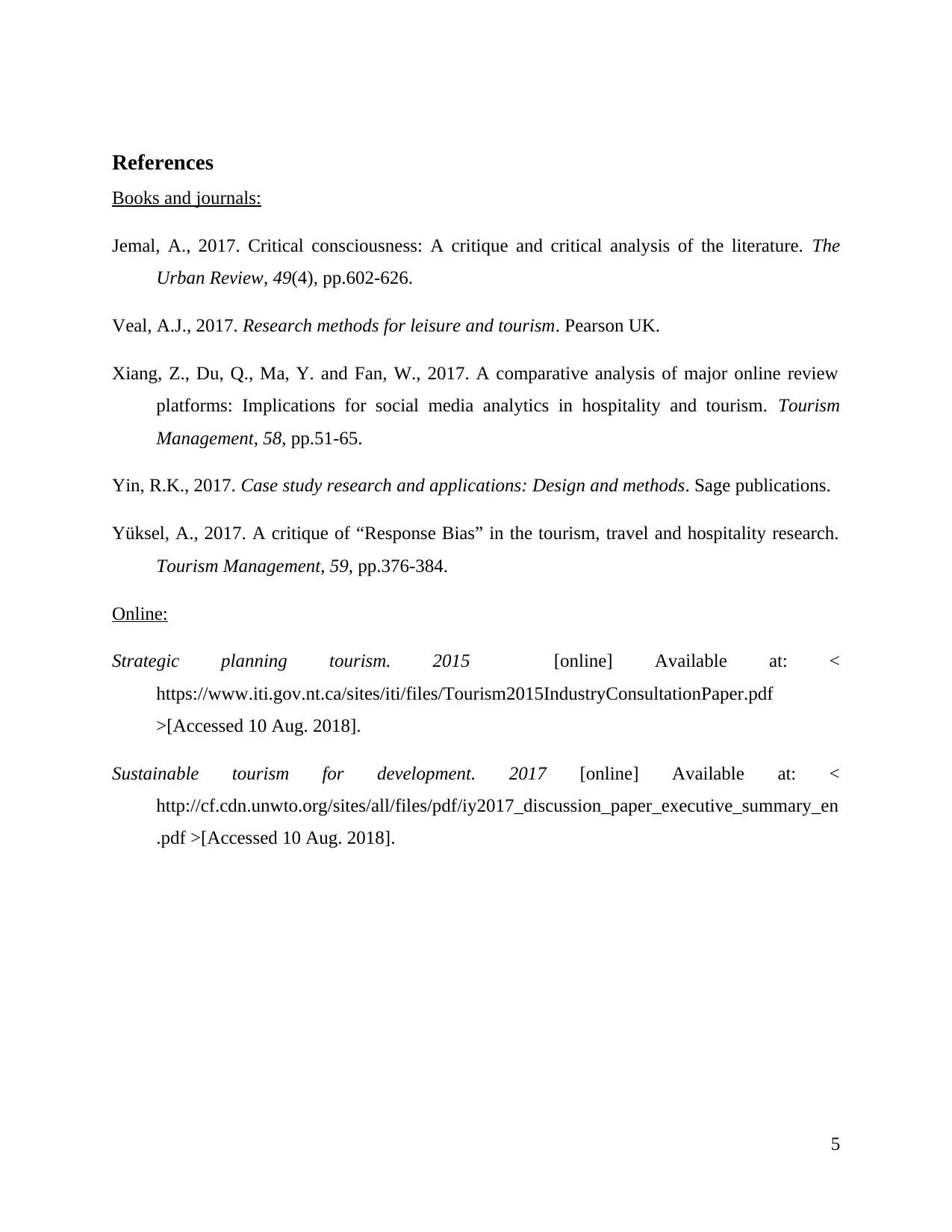
References
Books and journals:
Jemal, A., 2017. Critical consciousness: A critique and critical analysis of the literature. The
Urban Review, 49(4), pp.602-626.
Veal, A.J., 2017. Research methods for leisure and tourism. Pearson UK.
Xiang, Z., Du, Q., Ma, Y. and Fan, W., 2017. A comparative analysis of major online review
platforms: Implications for social media analytics in hospitality and tourism. Tourism
Management, 58, pp.51-65.
Yin, R.K., 2017. Case study research and applications: Design and methods. Sage publications.
Yüksel, A., 2017. A critique of “Response Bias” in the tourism, travel and hospitality research.
Tourism Management, 59, pp.376-384.
Online:
Strategic planning tourism. 2015 [online] Available at: <
https://www.iti.gov.nt.ca/sites/iti/files/Tourism2015IndustryConsultationPaper.pdf
>[Accessed 10 Aug. 2018].
Sustainable tourism for development. 2017 [online] Available at: <
http://cf.cdn.unwto.org/sites/all/files/pdf/iy2017_discussion_paper_executive_summary_en
.pdf >[Accessed 10 Aug. 2018].
5
Books and journals:
Jemal, A., 2017. Critical consciousness: A critique and critical analysis of the literature. The
Urban Review, 49(4), pp.602-626.
Veal, A.J., 2017. Research methods for leisure and tourism. Pearson UK.
Xiang, Z., Du, Q., Ma, Y. and Fan, W., 2017. A comparative analysis of major online review
platforms: Implications for social media analytics in hospitality and tourism. Tourism
Management, 58, pp.51-65.
Yin, R.K., 2017. Case study research and applications: Design and methods. Sage publications.
Yüksel, A., 2017. A critique of “Response Bias” in the tourism, travel and hospitality research.
Tourism Management, 59, pp.376-384.
Online:
Strategic planning tourism. 2015 [online] Available at: <
https://www.iti.gov.nt.ca/sites/iti/files/Tourism2015IndustryConsultationPaper.pdf
>[Accessed 10 Aug. 2018].
Sustainable tourism for development. 2017 [online] Available at: <
http://cf.cdn.unwto.org/sites/all/files/pdf/iy2017_discussion_paper_executive_summary_en
.pdf >[Accessed 10 Aug. 2018].
5
1 out of 7
Related Documents
Your All-in-One AI-Powered Toolkit for Academic Success.
+13062052269
info@desklib.com
Available 24*7 on WhatsApp / Email
![[object Object]](/_next/static/media/star-bottom.7253800d.svg)
Unlock your academic potential
Copyright © 2020–2025 A2Z Services. All Rights Reserved. Developed and managed by ZUCOL.





